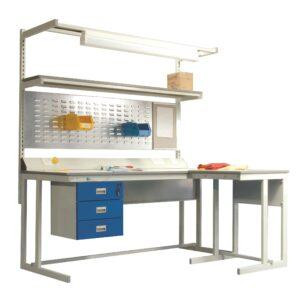In the realm of electronics manufacturing, ESD workbenches have become a critical component in ensuring the longevity and reliability of electronic components. ESD, or Electrostatic Discharge, can cause significant damage to sensitive electronic devices, leading to costly repairs and replacements. Implementing an ESD workbench is a proactive measure to mitigate these risks.
An ESD workbench is specially designed to prevent static electricity build-up, which can discharge and damage electronic components. These workbenches are constructed using materials that are resistant to static electricity, such as conductive or dissipative materials, ensuring that any static charge is safely grounded. The primary function of an ESD workbench is to create a controlled environment where electronic components can be handled safely without the risk of electrostatic discharge.
One of the key features of an ESD workbench is its grounding system. The workbench is equipped with a grounding point that connects to a grounding system, ensuring that any static electricity is safely dissipated. This grounding system is essential for maintaining a static-free environment, as it provides a direct path for any static charge to be neutralized. Additionally, an ESD workbench typically includes wrist straps and heel grounders for operators, further enhancing the protection against ESD.
ESD benches also come with anti-static mats and surface coverings that provide an additional layer of protection. These mats are made from materials that either conduct electricity or dissipate static charges, ensuring that the work surface remains free from static build-up. Moreover, these benches often feature adjustable shelving and storage options, allowing for a flexible and organized workspace tailored to the specific needs of the operator.
Incorporating ESD bench into the manufacturing process not only protects the electronic components but also improves overall efficiency. By reducing the risk of ESD-related damage, companies can decrease downtime and avoid the costs associated with repairing or replacing damaged components. This investment in ESD workbenches ultimately leads to higher product quality and reliability, which is essential in maintaining customer satisfaction and trust.
Furthermore, the use of ESD workbenches is often a requirement in industries where high-reliability electronic components are produced, such as aerospace, medical devices, and telecommunications. Compliance with industry standards and regulations regarding ESD protection is crucial, and an ESD workbench plays a vital role in meeting these requirements.
In conclusion, an ESD workbench is an indispensable tool in modern electronics manufacturing. Its ability to prevent electrostatic discharge and protect sensitive components is crucial for maintaining product quality and reliability. By investing in ESD benches, manufacturers can enhance their production processes, ensure compliance with industry standards, and ultimately deliver superior products to their customers.





Comments